Analysis of Rock Mass Energy Characteristics and Induced Disasters Considering the Blasting Superposition Effect
Abstract
:1. Introduction
2. Characteristics of Energy Distribution Induced by Excavation
2.1. Calculation Results of Energy Distribution
2.2. Energy Characteristics of Deep Mining with Numerical Simulation
3. Superimposed Analysis of Blasting Vibration Energy
3.1. Monitoring of Blasting Impact Speed
3.2. Study on the Superposition of Equivalent Kinetic Energy of Vibration
4. Analysis of Rockburst Tendency
5. Conclusions
- (1)
- Based on the measured data on in situ stress, the quasi-static energy accumulation characteristics of the surrounding rock of a three-core arch tunnel after excavation were derived. The maximum energy accumulation values at the top and sides of the tunnel are 90.3 kJ/m3, and 147.5 kJ/m3 at the bottom, both occurring at a distance of approximately 5 m from the free face.
- (2)
- Based on the equivalent elastic vibration theory and near-field monitoring data, an initial elastic shock wave velocity of about 4–6 m/s was obtained. Through experiments on the propagation and attenuation of shock energy, it was found that the initial average value of the increase in near-field surrounding rock energy caused by blasting shock was 30 kJ, and it decayed exponentially with the propagation distance.
- (3)
- To analyze the energy scattering characteristics, an improved SHPB experiment was conducted with different shapes of incident rods. Based on the principle of geometric similarity, the impact energy scattering rate after tunnel blasting was 40%, and the superimposed energy was about 60% of the original impact energy.
- (4)
- After considering propagation and scattering, the maximum energy accumulation value at the top and sides of the tunnel is 108.3 kJ/m3, and 165.5 kJ/m3 at the bottom. The energy accumulation value has increased by 19.9% and 12.2%, respectively. The possibility and intensity of rockbursts both increase, which to some extent enhances the potential threat of dynamic disasters such as rockbursts.
Author Contributions
Funding
Data Availability Statement
Conflicts of Interest
References
- Xie, H.; Gao, F.; Ju, Y.; Ru, Z.; Gao, M.; Deng, J. Novel ideas and disruptive technologies for the exploration and research of deep earth. Adv. Eng. Sci. 2017, 49, 1–8. (In Chinese) [Google Scholar]
- Li, X.; Yao, J.; Gong, F. Dynamic problems in deep exploitation of hard rock metal mines. Chin. J. Nonferrous Met. 2011, 21, 2551–2563. (In Chinese) [Google Scholar]
- Chen, B.-R.; Feng, X.-T.; Li, Q.-P.; Luo, R.-Z.; Li, S. Rock Burst Intensity Classification Based on the Radiated Energy with Damage Intensity at Jinping II Hydropower Station, China. Rock Mech. Rock Eng. 2015, 48, 289–303. [Google Scholar] [CrossRef]
- Xu, J.; Jiang, J.; Xu, N.; Liu, Q.; Gao, Y. A new energy index for evaluating the tendency of rockburst and its engineering application. Eng. Geol. 2017, 230, 46–54. [Google Scholar] [CrossRef]
- Wang, J.; Ning, J.; Jiang, J.; Bu, T.; Shi, X. Research on the Energy Criterion for Rockbursts Induced by Broken Hard and Thick Rock Strata and Its Application. Geotech. Geol. Eng. 2017, 35, 731–746. [Google Scholar] [CrossRef]
- Najm, S.J.; Daraei, A. Forecasting and controlling two main failure mechanisms in the Middle East’s longest highway tunnel. Eng. Fail. Anal. 2023, 146, 107091. [Google Scholar] [CrossRef]
- Cai, M.; Ji, D.; Guo, Q. Study on rockburst prediction based on in-situ stress measurement and theory of energy accumulation caused by mining disturbance. Chin. J. Rock Mech. Eng. 2013, 3, 1973–1980. (In Chinese) [Google Scholar]
- Zhang, F. Research on the Energy Evolution Characteristics and Unloading Degradation Failure Mechanism of Deep Coal Seam Floor Rock Mass. J. Min. Saf. Eng. 2023, 40, 346–353. [Google Scholar]
- Liu, C.; Yin, S.; Zhang, J.; Zhang, D.; Wang, L.; Zhao, H. Study on the acoustic emission and energy evolution law of sandstone fracture under deep mining stress conditions. J. Min. Saf. Eng. 2022, 39, 470–479. [Google Scholar]
- Xiao, P.; Li, D.; Zhao, G.; Liu, H. A new criterion for the spalling failure of deep rock engineering based on energy release. Int. J. Rock Mech. Min. Sci. 2021, 148, 104943. [Google Scholar] [CrossRef]
- Zheng, K.; Shi, C.; Lou, Y.; Jia, C.; Lei, M.; Yang, Y. A computational method for tunnel energy evolution in strain-softeningrock mass during excavation unloading based on triaxial stress path. Comput. Geotech. 2024, 169, 106212. [Google Scholar] [CrossRef]
- Ma, B.; Xie, H.; Zhou, C.; Zhou, H.; Gao, F.; Cao, P.; Zhu, J. Experimental investigation into influence of surrounding rock on strainburst: Insight from failure process and energy partition. Int. J. Rock Mech. Min. Sci. 2024, 175, 105685. [Google Scholar] [CrossRef]
- Hao, Y.; Liu, C.; Wu, Y.; Pu, H.; Chen, Y.; Shen, L.; Li, G. Numerical modeling on strain energy evolution in rock system interaction with energy-absorbing prop and rock bolt. Int. J. Min. Sci. Technol. 2023, 33, 1273–1288. [Google Scholar] [CrossRef]
- Yang, J.; Lu, W.; Jiang, Q.; Yao, C.; Jiang, S.; Tian, L. A Study on the Vibration Frequency of Blasting Excavation in Highly Stressed Rock Masses. Rock Mech. Rock Eng. 2016, 49, 2825–2843. [Google Scholar] [CrossRef]
- Duan, B.; Xia, H.; Yang, X. Impacts of bench blasting vibration on the stability of the surrounding rock masses of roadways. Tunn. Undergr. Space Technol. 2018, 71, 605–655. [Google Scholar] [CrossRef]
- Fan, Y.; Lu, W.B.; Yan, P.; Chen, M.; Zhang, Y. Transient characters of energy changes induced by blasting excavation of deep-buried tunnels. Tunn. Undergr. Space Technol. 2015, 49, 9–17. [Google Scholar] [CrossRef]
- Xie, H. Research framework and anticipated results of deep rock mechanics and mining theory. Adv. Eng. Sci. 2017, 49, 1–16. (In Chinese) [Google Scholar]
- Chen, S.; Chu, S.; Gong, J.; Liu, M.; Chang, X.; Li, H. Study on the vibration response of sandstone tunnel surrounding rock blasting under high ground stress. Vib. Impact 2022, 41, 73–80. [Google Scholar]
- Chen, L.; Zhou, Z.; Gao, S.; Cai, X.; Wang, S.; Nie, S.; Cao, H. Current Status and Prospects of High-Stress Tunnel Blasting Research. J. Cent. South Univ. (Nat. Sci. Ed.) 2023, 54, 849–865. [Google Scholar]
- He, B.; Armaghani, D.J.; Lai, S.H.; He, X.; Asteris, P.G.; Sheng, D. A deep dive into tunnel blasting studies between 2000 and 2023—A systematic review. Tunn. Undergr. Space Technol. 2024, 147, 105727. [Google Scholar] [CrossRef]
- Li, X.; Liu, K.; Sha, Y.; Yang, J.; Hong, Z. Experimental and numerical investigation on rock fracturing in tunnel contour blasting under initial stress. Int. J. Impact Eng. 2024, 185, 104844. [Google Scholar] [CrossRef]
- Li, Q.; Xiang, B. Rockburst Prediction on the Superimposed Effect of Excavation Accumulation Energy and Blasting Vibration Energy in Deep Roadway. Shock Vib. 2021, 2021, 6644590. [Google Scholar] [CrossRef]
- Fan, Y.; Lu, W.; Zhou, Y.; Yan, P.; Chen, M. Study on energy release process of high energy storage rock mass induced by excavation unloading. Chin. J. Rock Mech. Eng. 2016, 35 (Suppl. S2), 3706–3715. [Google Scholar]
- Li, Q.; Chen, L. Based on the accurate blasting loading to estimate the safety criterion. Eng. Mech. 2015, 32, 123–129. (In Chinese) [Google Scholar]


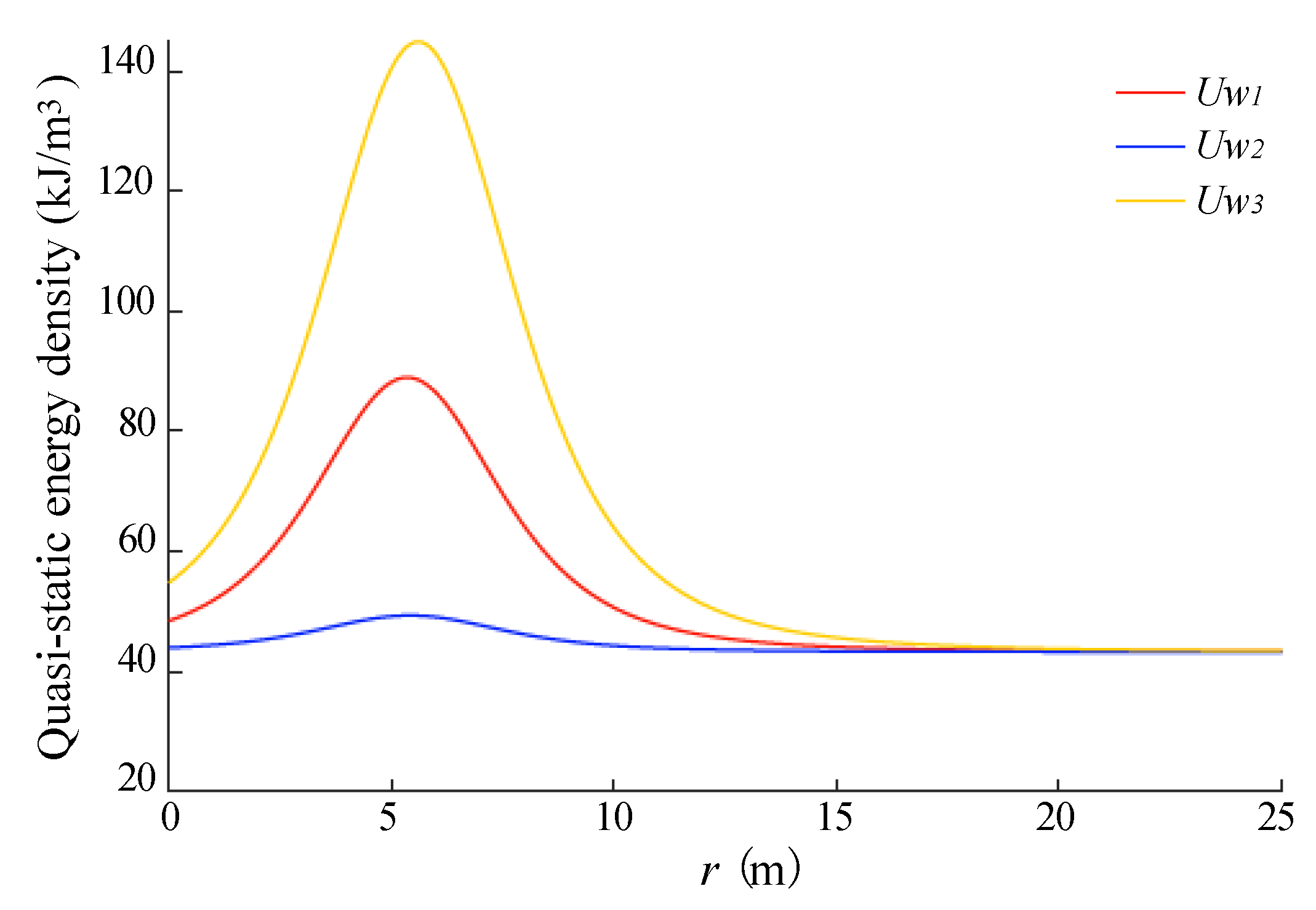


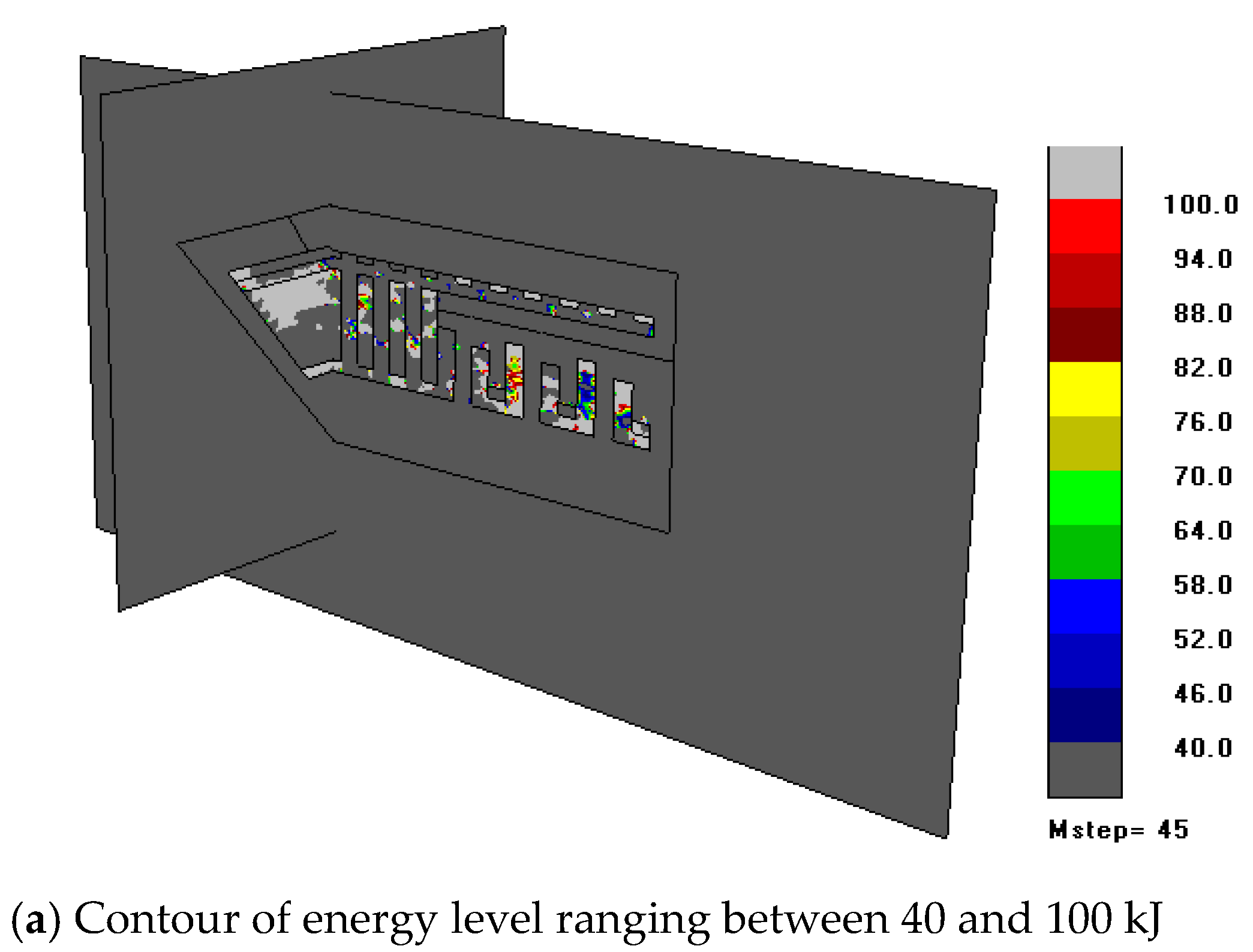
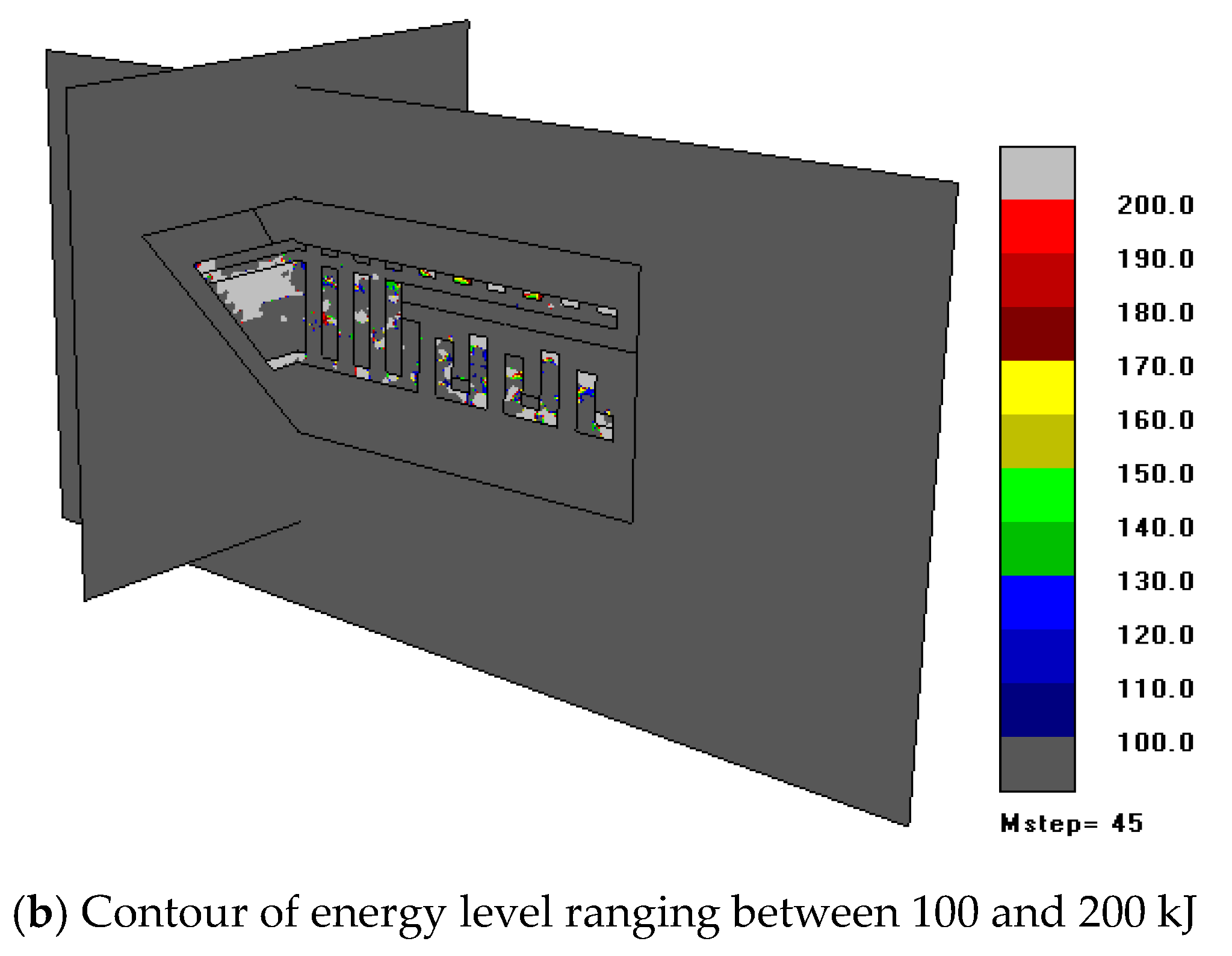

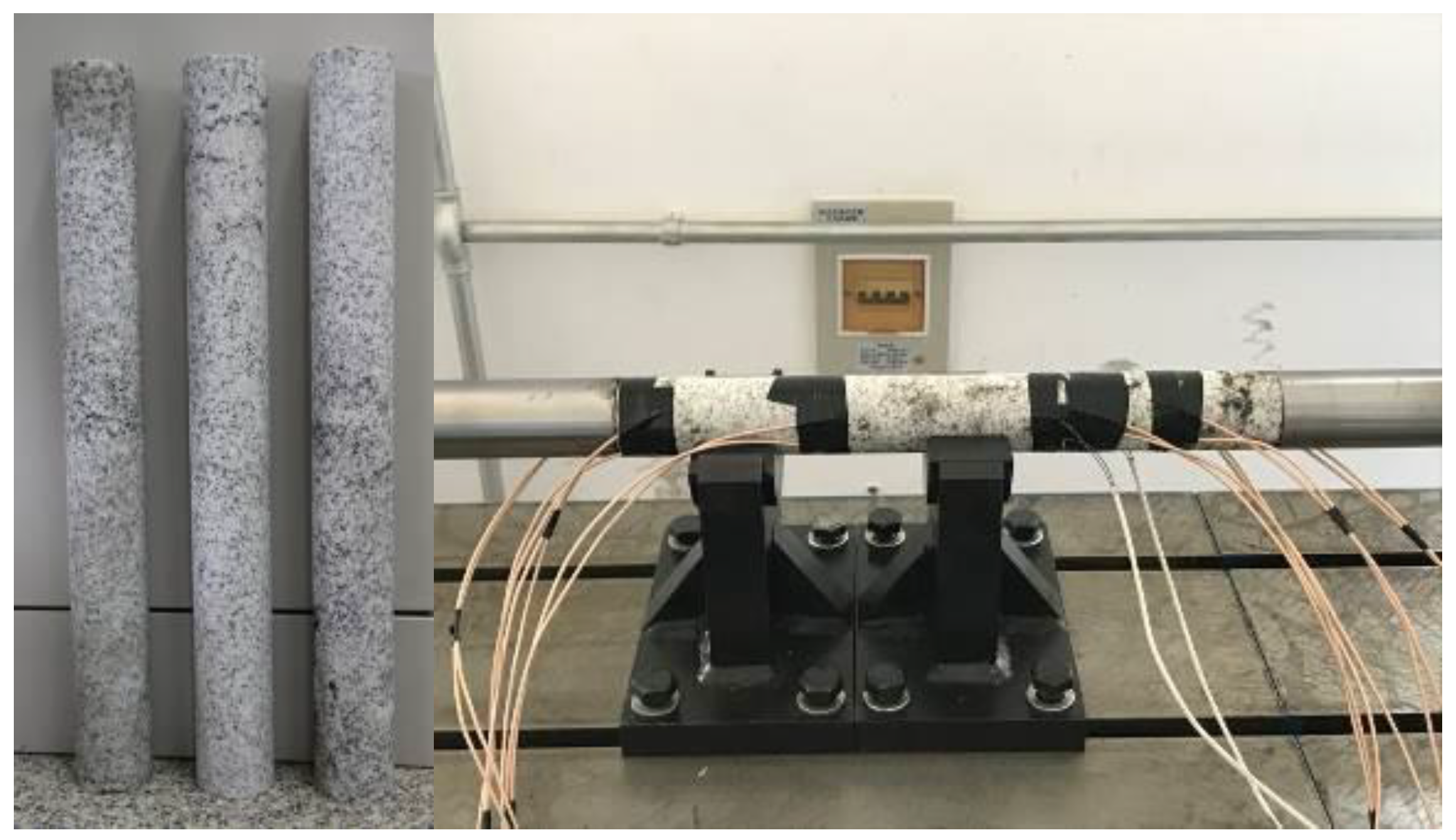
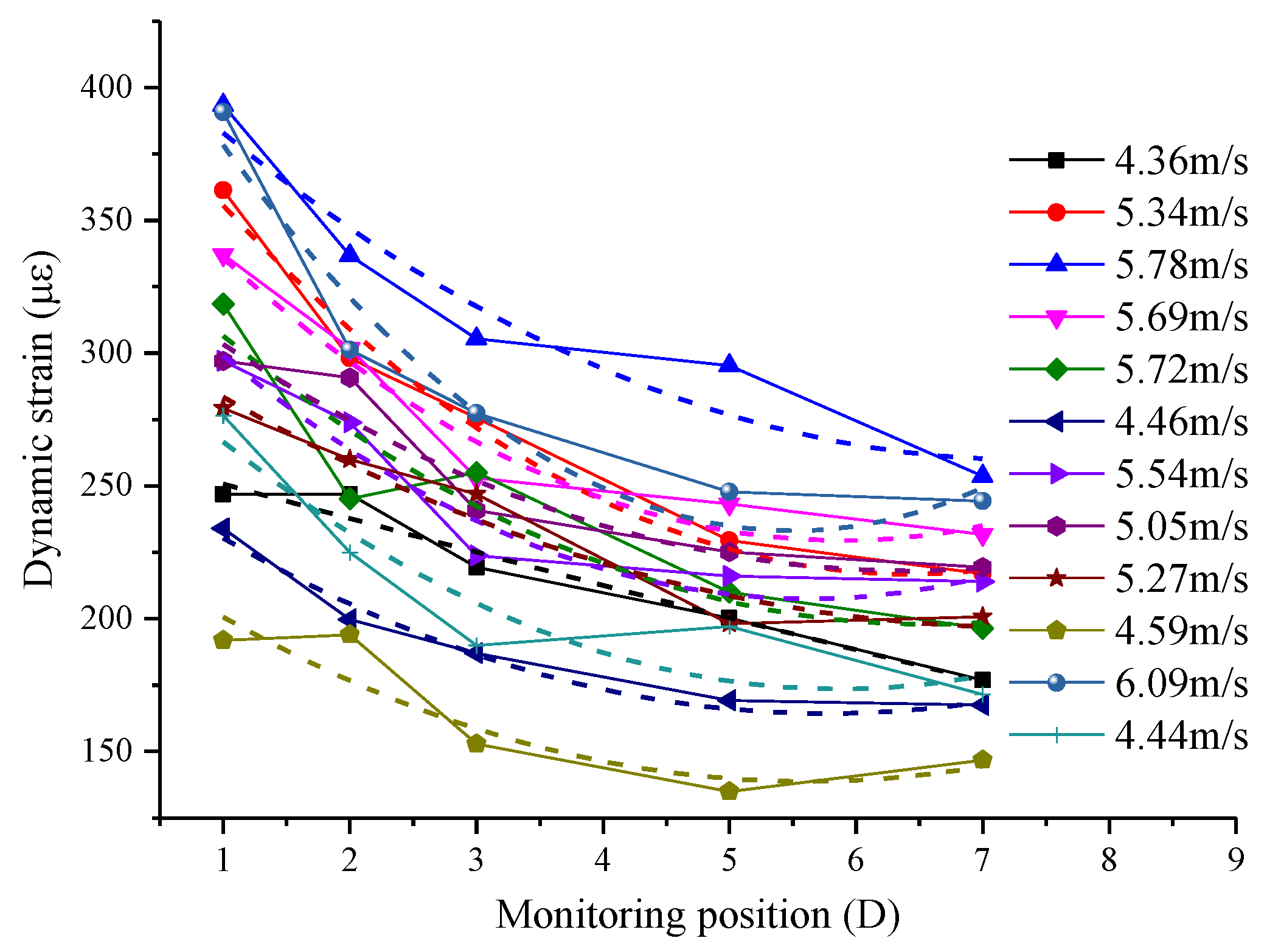
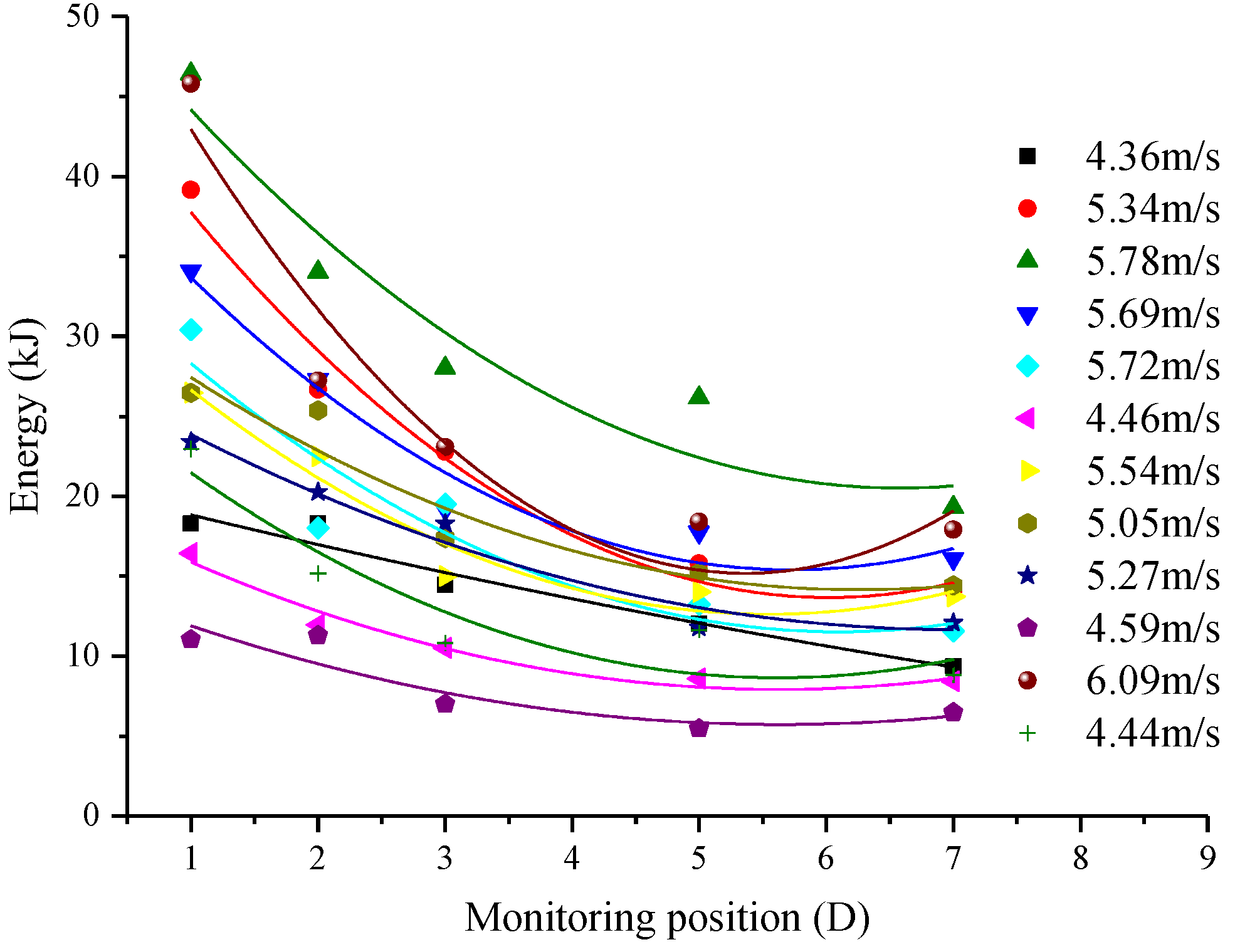
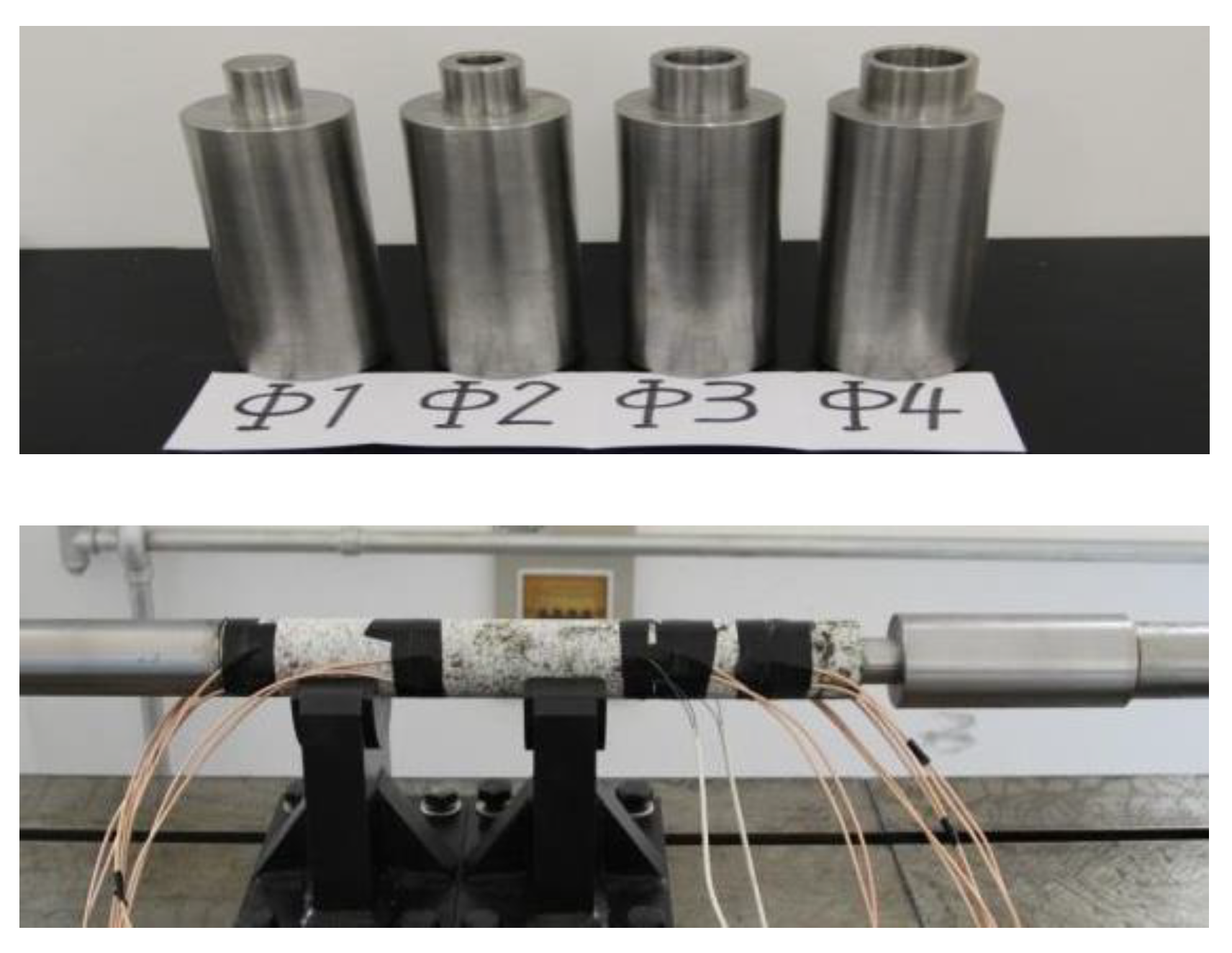
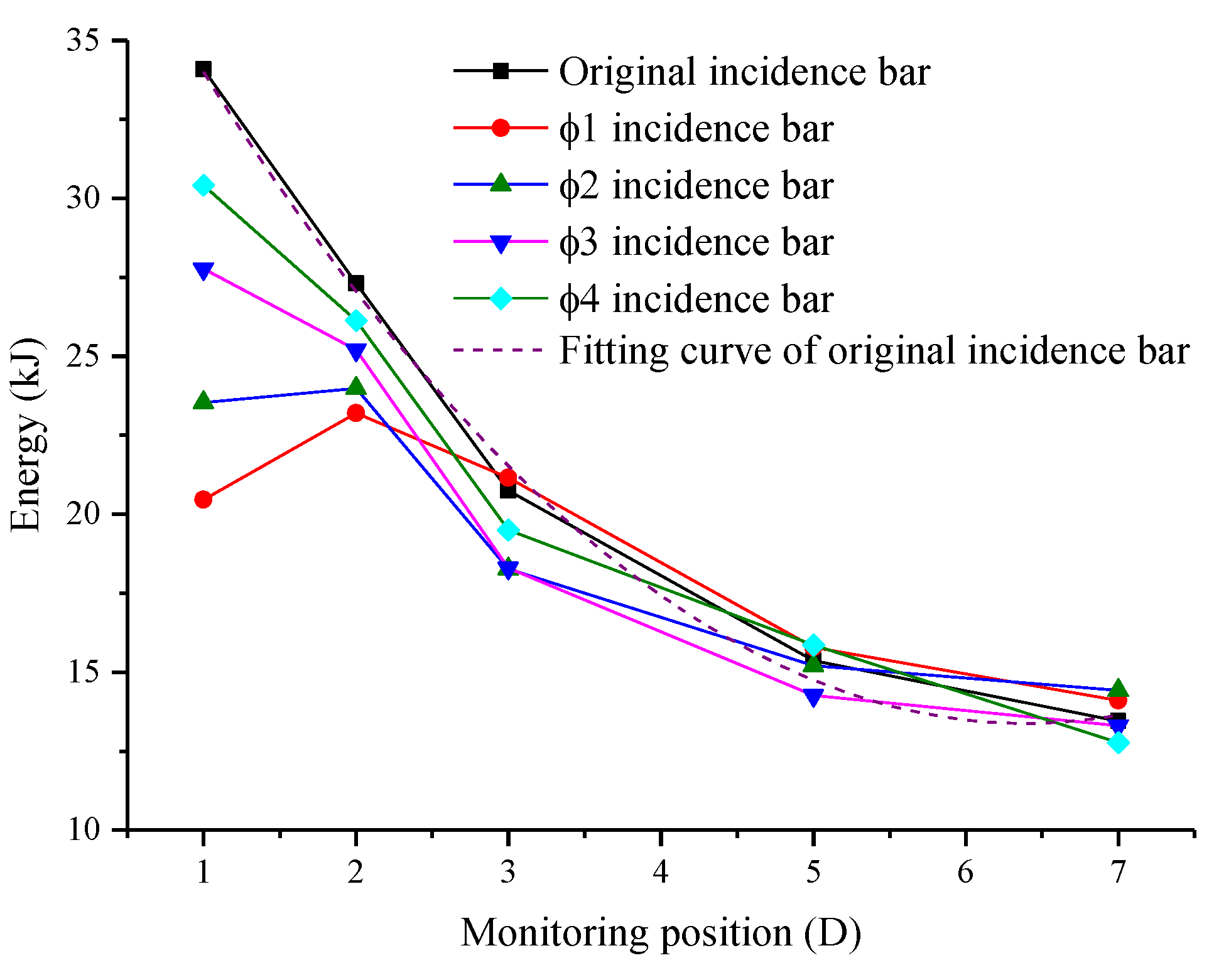

| Burst Distance R/m | X-Direction Vibration Speed V1/ms−1 | Y-Direction Vibration Speed V2/ms−1 | Z-Direction Vibration Speed V3/ms−1 | Maximum Synthesis Speed V/ms−1 |
|---|---|---|---|---|
| 4.2 | 1.82 | 1.23 | 1.91 | 2.91 |
| 3.6 | 2.12 | 2.04 | 1.79 | 3.44 |
| 2.4 | 3.52 | 3.36 | 3.51 | 6.00 |
| 4.4 | 2.12 | 2.04 | 1.79 | 3.44 |
| 3.8 | 2.35 | 2.24 | 2.23 | 3.94 |
| 3.2 | 2.12 | 2.04 | 1.79 | 3.44 |
| 2.6 | 3.18 | 2.79 | 2.89 | 5.12 |
| Rockburst Level | No Rockburst | Slight Rockburst | Moderate Rockburst | Strong Rockburst |
|---|---|---|---|---|
| Numerical range (kJ/m3) | Ue < 40 | 40 < Ue < 100 | 100 < Ue < 200 | Ue > 200 |
Disclaimer/Publisher’s Note: The statements, opinions and data contained in all publications are solely those of the individual author(s) and contributor(s) and not of MDPI and/or the editor(s). MDPI and/or the editor(s) disclaim responsibility for any injury to people or property resulting from any ideas, methods, instructions or products referred to in the content. |
© 2024 by the authors. Licensee MDPI, Basel, Switzerland. This article is an open access article distributed under the terms and conditions of the Creative Commons Attribution (CC BY) license (https://creativecommons.org/licenses/by/4.0/).
Share and Cite
Chen, L.; Yang, X.; Guo, L.; Yu, S. Analysis of Rock Mass Energy Characteristics and Induced Disasters Considering the Blasting Superposition Effect. Processes 2024, 12, 1089. https://doi.org/10.3390/pr12061089
Chen L, Yang X, Guo L, Yu S. Analysis of Rock Mass Energy Characteristics and Induced Disasters Considering the Blasting Superposition Effect. Processes. 2024; 12(6):1089. https://doi.org/10.3390/pr12061089
Chicago/Turabian StyleChen, Lu, Xiaocong Yang, Lijie Guo, and Shibo Yu. 2024. "Analysis of Rock Mass Energy Characteristics and Induced Disasters Considering the Blasting Superposition Effect" Processes 12, no. 6: 1089. https://doi.org/10.3390/pr12061089








